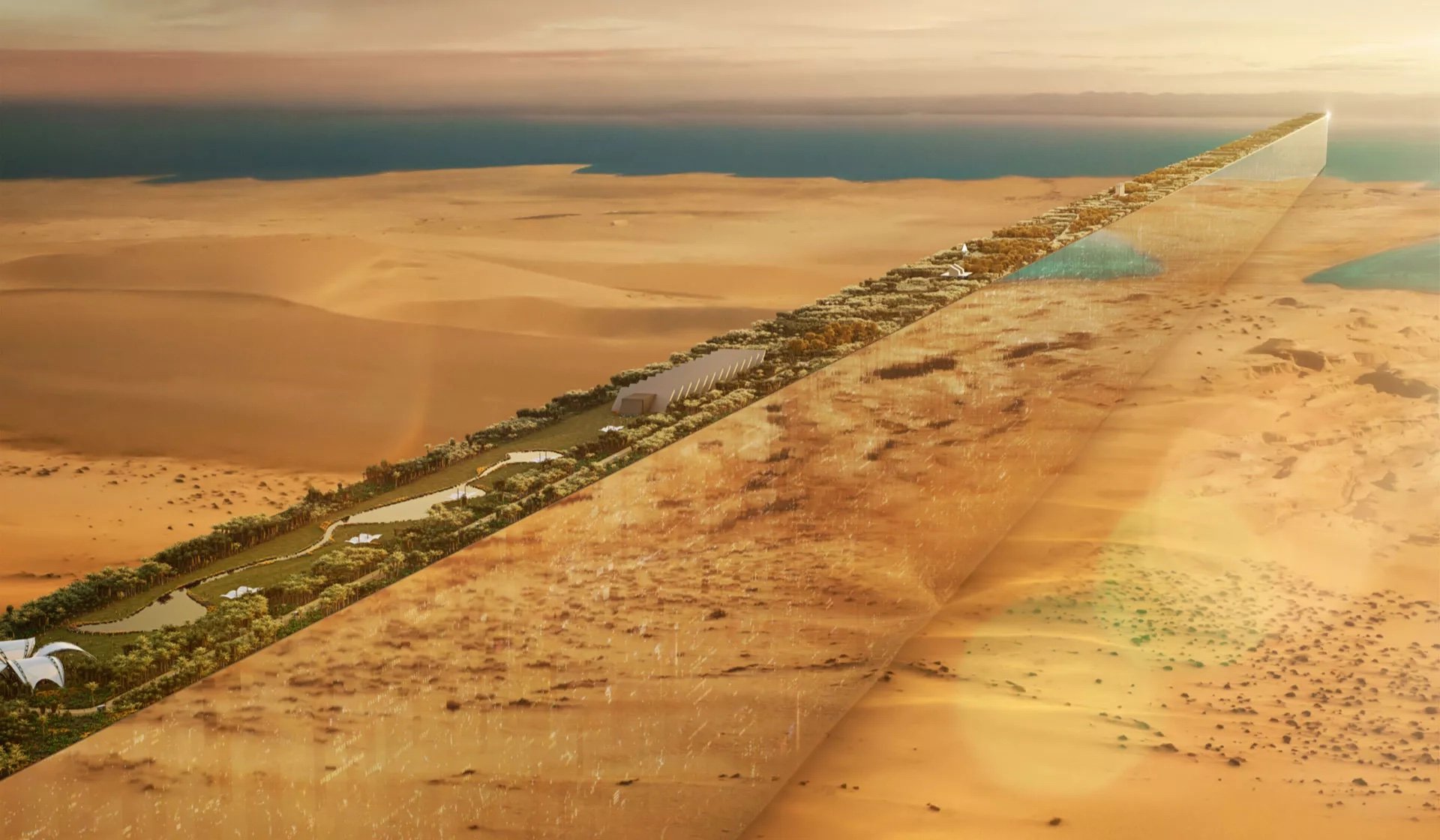The Line: Luxurious Environmentally Sustainable Infrastructure with a Cost
Image courtesy of NEOM
Neom: the future. Saudi Arabia envisioned Neom or also considered the Line as a stable microclimatic environment that prioritizes walkability, clean energy, and technology to move away from traffic, pollution, and other infrastructure challenges that plague urban life. Considered a futuristic city powered entirely by clean energy with no roads, cars, or emissions, the Line was designed to respond to some of the most pressing global challenges facing urban cities and ultimately emulate a new way of living.
The Line will be located in the Tabuk province of northwestern Saudi Arabia. Its total capacity will hold nine million people, sitting at only 200 meters wide and almost 170 kilometers long. The Line will house services such as clinics, and food venues, all within a five minute walk from people’s residences and with a high-speed train that residents can use to travel from one end of the city to the other in under 20 minutes. With a cost of over a trillion dollars to fund the construction of the Line, the Kingdom of Saudi Arabia attempts to no longer “ignore livability and the environmental crisis facing our world’s citizens.” Crown Prince Mohammed bin Salaman is prioritizing Saudi citizen’s health and well-being over transportation through this innovative, futuristic infrastructure.
It is no secret that without government action to make cities more sustainable, climate change and increased carbon dioxide emissions will decrease citizens’ quality of life. By 2050, scientists estimate that “commute durations will double, and one billion people will have to relocate”everywhere due to these rising carbon dioxide emissions and “90 percent of people will breathe polluted air.” Considering the effects of carbon dioxide emissions, the Saudi government stresses the importance of the Line and how it will run on 100 percent renewable energy from various inputs, including solar, wind, and hydrogen-based generation. Additionally, the Line will be considered a regional powerhouse by diversifying water production and desalination, which has always been a significant challenge in the Kingdom of Saudi Arabia. With a growing population and environmental limitations to sustain the increasing demand for water, Saudi is utilizing future infrastructure to solve these challenges.
What other intentions did the Kingdom of Saudi have that prompted them to take on such a massive infrastructure with an emphasis on environmental sustainability? While climate change statistics are used as justification for the project’s development, the Line can also be considered part of Saudi’s geopolitical strategy. Specifically, a method by which the Kingdom can diversify its economy and reduce its dependency on vast oil reserves. According to the U.S. Energy and Information Administration, Saudi Arabia’s exports have risen by 2.5 percent as they “export 7.38 million barrels per day,” where “53 percent of Saudi’s government's revenues were oil-based,”. The Kingdom of Saudi Arabia’s economy is significantly dependent on oil which is not sustainable in the long run, nor is it environmentally friendly. The development of the Line will reduce their reliance on oil by building infrastructure that can capture other forms of investment through the tourism industry while increasing the welfare of their citizens. The business and technology center of the Line is expected to contribute over 48 billion to Kingdom’s Gross Domestic Product and generate around 380,000 jobs. However, it is interesting that the “vast majority of funds were accumulated from the successful oil economy,” which are now directed toward the Line.
While the Line is in theory a promising concept for environmental sustainability whilst maintaining a luxurious experience, there are a variety of controversies regarding its development. The Lineis meant to preserve 95 percent of the natural environment around the site, illustrating a new relationship between infrastructure and the environment. However, this is not the case, as there are a variety of damaging effects on the Tabuk province ecosystem and tribal communities. There was little consideration for the millions of migratory birds that cross the Line’s trajectory annually, with the city's meter wall being an inhibitor.
Additionally, the Kingdom of Saudi Arabia argues that the location of the Line is a “virgin area that has a lot of beauty,” highlighting the desert expanses and azure lagoons, but they fail to acknowledge the indigenous populations living there. In fact, the Line will cause eviction for over 20,000 Al-Huwaitat tribes people who have lived in the region for generations. The late Abdul Rahim al-Huwaiti has become the face of the tribe’s criticism of their forced eviction and uses social media to respond to Saudi officials. According to The Guardian, Abdul among other members from the tribe highlight how the Saudi government will “arrest anyone who is against deportation.” In fact, the recent death of Abdul Rahim al-Huwaiti has heightened both political tensions but also the question of human rights in terms of the Kingdom’s treatment of the Huwaiti people. Abdul recorded a video in his home where Saudi government officials were seen and engaged in gunfire that resulted in his death. While the Saudi government attempted to cover up his killing through social media censorship, it is evident that there is a lack of care toward tribal communities and their needs during this new development.
Despite the controversy, the legacy of the Line is held in high regard amongst its citizens and in other parts of the world. This city exemplifies a new development in infrastructure with zero carbon emissions and revolutionizing urbanization. One citizen even claim that it's the “boldest, most ambitious idea to come out of our kingdom this decade,” where he argues that Crown Prince Mohammed bin Salaman is paving the way for a modern era where environmentally sustainability is prioritized and where man along with nature can coexist. The Line symbolizes the beginning of environmentally sustainable infrastructure that can enrich the lives of humans. While it holds some controversies, it is a step in the right direction to positively impact our environment and curtail climate change as much as possible.





